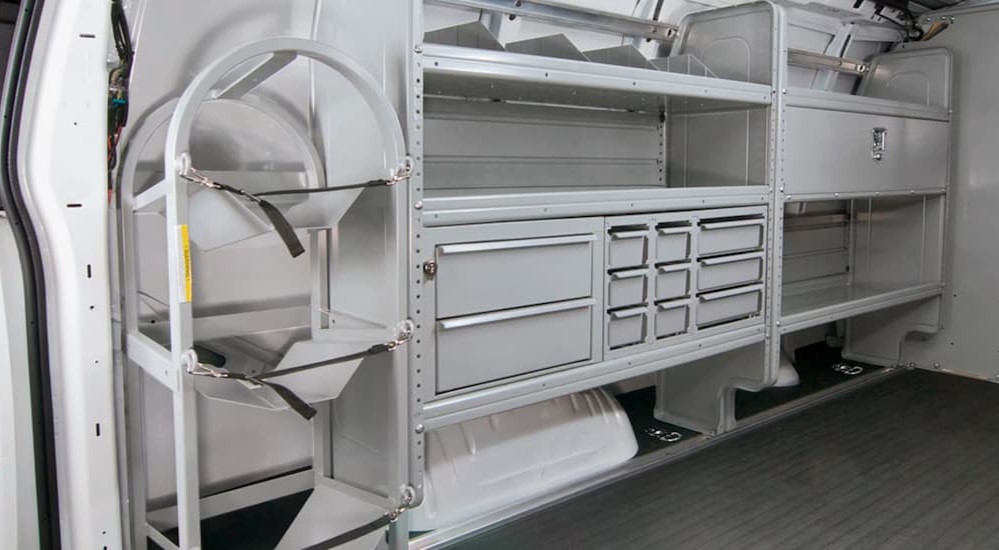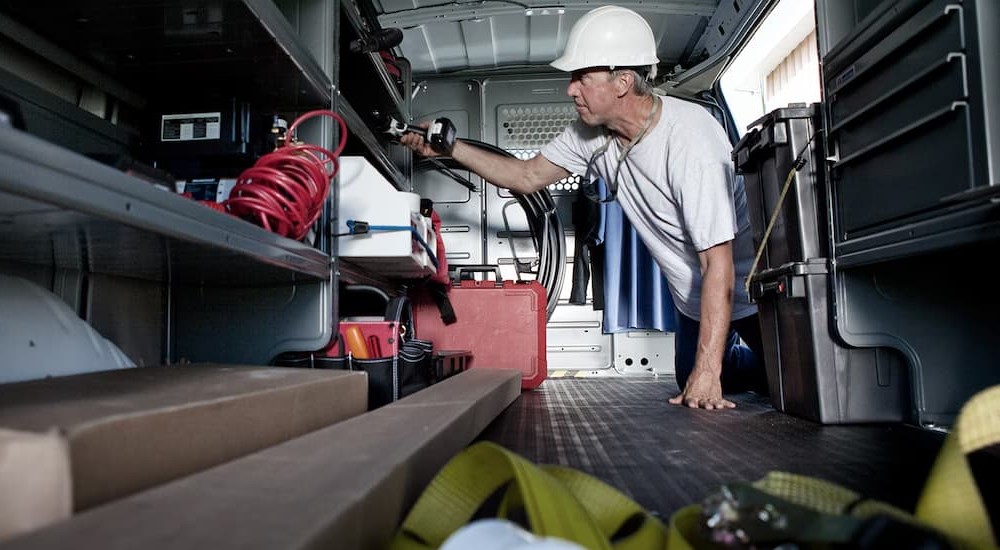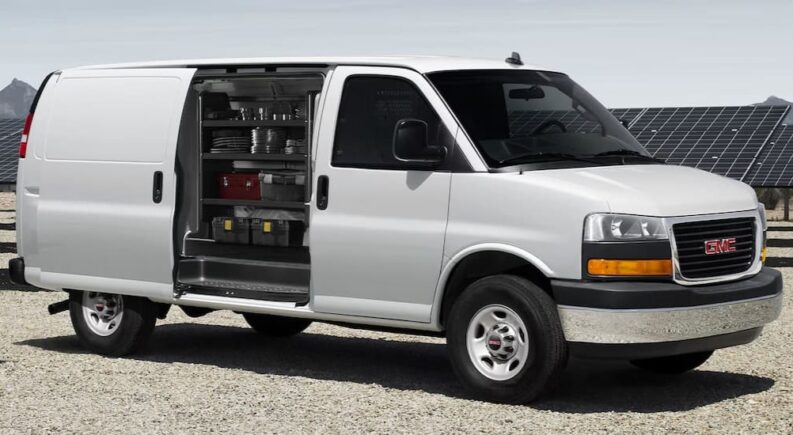Some spend their workdays staring at the walls of a drab, grey cubicle, but if you’re a hardworking trade pro or delivery driver, the scenery can change with every passing mile. This sort of mobile office affords a number of benefits, from the freedom of the open road to the opportunity to jam out to your favorite tunes or catch up on some podcasts. However, there is one major drawback. Say what you want about traditional office life, but it does offer one advantage: cubicles don’t need regular maintenance.
The same can’t be said for your delivery van, which, like any vehicle, requires regular visits to your local service center. Keeping up with delivery van service is a vital part of the job. It not only helps to reduce overhead by keeping fuel and repair costs low, but it also guarantees consistent performance that’ll keep you from having to miss out on profitable projects when the van decides to call in sick.
Any time your delivery van spends in the shop is time not spent making your rounds, which is why regular service is so important. We’ve compiled a short guide outlining some of the most important service tasks associated with the typical delivery van. Whether you’re toting packages and supplies around town or simply using your cargo van as a weekend camping rig, you’ll want to review some of these basic tips and tricks.
Know What You’re Getting Into
While I don’t count myself among the estimated 1.4 million Americans who currently work as a delivery driver, I do know a thing or two about the so-called “van life.” Purchasing a pre-millennium GMC Savana 1500 during the pandemic seemed like a good idea. While it’s been a lot of fun to explore new corners of my state (and more than a few Wal-Mart parking lots) in my readymade adventure vehicle, it has presented a few difficulties from a repair and maintenance perspective.
The biggest challenge comes down to a lack of accessibility. While I’m not a total newbie when it comes to the mysteries of internal combustion, even some of the simplest projects have proved difficult, thanks to the unique design of my half-ton home-away-from-home. Like many popular half-ton cargo vans, the Savana 1500 (which is almost identical to the Chevy Express 1500) features a short-nosed design that drastically limits access to the engine compartment. Popping the hood will allow you to check on a few vital fluids, the radiator, and the fuse box, but not much else. In order to access the engine itself, drivers will either have to crawl under the van or spend a little time rooting around beneath the interior engine access cover, also referred to as the “dog house.” No one likes spending time in the dog house, especially van owners. It’s a cramped little nook, and while some experienced mechanics might be able to work wonders in this limited space, the average driver could find the claustrophobic quarters a little overwhelming.
Thanks to the Savana’s unique design, even some of the easiest maintenance tasks can get a little tricky. While anyone with a torque wrench should be able to swap out a set of spark plugs, the job is complicated by the fact that the Savana’s cylinders can only be accessed by removing the two front tires. What should be a simple 30-minute job now requires the use of a jack, jack stands, and a little extra patience. It’s just one example of some of the complications that come with van ownership, but it’s all part of the job for those who drive for a living. Before you go to invest in your next delivery vehicle, take a moment to consider different designs. If you’re comfortable working in tight spaces or plan on outsourcing most of your repair and maintenance work, a short-nosed design might not be a deal breaker.

Stick to the Severe Maintenance Schedule
Most drivers use their vehicles to get to and from work, but when your van is your workplace, it’s easy to start racking up the miles. While the average U.S. driver logs around 14,000 miles per year, that number easily rises to nearly 22,000 in the case of full-size delivery vans, according to the National Transportation Energy Data Book. Your odometer will surely get a workout when you spend your days delivering packages or other precious cargo, but it’s not just the sheer number of miles you’re putting on your vehicle. It’s the way in which the van is driven.
Operating a delivery vehicle involves a lot of stop-and-go driving and a lot more idling than the average car, truck, or SUV. This lack of downtime can lead to premature wear and tear to the engine, as well as the tires, brakes, rotors, and more. In order to keep a delivery van working at its best, drivers should consider following their vehicle’s “severe” maintenance schedule. This accelerated program of maintenance and repair tasks can be found in your owner’s manual or through a quick internet search. It can pay real dividends for delivery drivers, as well as those who spend a lot of time towing, off-roading, or operating in hot, dusty conditions.
A severe maintenance schedule will typically involve frequent replacement of air filters, brake pads and rotors, tires, oil, and transmission fluid. Different vehicles might have slightly different needs. For example, a delivery van designed with front-wheel drive will see the front tires wear out a little faster than the rear tires. Regular tire rotation can help to prolong the replacement interval, but regular inspections are key in order to ensure safety and performance. As always, remember to use high-quality, original equipment manufacturer (OEM) parts and fluids whenever possible, especially when performing an oil change.
Maximize Fuel Efficiency
Keeping up with your van’s maintenance schedule and promptly addressing any repairs is especially important when your vehicle doubles as a source of income. Underinflated tires, clogged air filters and fuel injectors, worn-out spark plugs, and other failing components can have a significant impact on a vehicle’s fuel economy. This might not be a huge issue when you’re only in the car for the length of your commute, but it’s a whole different ball game if you regularly spend an eight-hour shift behind the wheel.
Decreased fuel economy can lead to a hefty bill at the gas pump, which can have a significant impact on your operation’s bottom line. According to some estimates, a 10 MPG gulf in fuel economy can cost a driver as much as $4,480 over the course of five years. That’s no small chunk of change, so make sure to keep an eye on your gauges. Most new vehicles come standard with a built-in function that’ll monitor fuel economy, but if you’re the proud owner of an older model, try to regularly run the numbers and make sure you’re not burning through your profits thanks to an inefficient engine.
In addition to staying on top of routine maintenance, drivers can also practice some good driving habits that’ll squeeze a few extra miles out of every gallon. From limiting rapid acceleration and braking to employing cruise control and limiting excess weight, these best practices can go a long way toward making each visit to the pump a little less painful from a financial perspective.
Schedule Off-Hours Repairs
When you use your vehicle for work, keeping up with repair and maintenance can be a bit of a Catch-22. If you want to enjoy consistent performance, you’ll need to make regular visits to your local repair shop or dealership, but in order to afford these appointments, you need to make the most of every workday. This can present some real problems as the typical repair shop or service center sticks to the same nine-to-five schedule as the rest of the working world. Luckily, there are plenty of options for drivers who can’t afford a lot of downtime. There are a number of shops that specialize in servicing delivery vans and other fleet vehicles, offering extended hours that’ll allow you to roll in well after the typical 5 PM cutoff. This sort of service can be a lifesaver for drivers seeking a little off-hours repair or maintenance work, but it’s not the only option. Some shops even operate a mobile repair van that can come right to you, performing basic maintenance tasks like oil changes, tire rotation and replacement, and more from the comfort of your own driveway or warehouse parking lot.

Invest in an OBD-II Scanner
While the delivery industry’s major players have a team full of qualified mechanics and maintenance technicians at their beck and call, these luxuries are typically not on the table for the little guy. A trusted local mechanic can help to head off some of the most significant and expensive maintenance and repair tasks, but what’s a driver to do in between their regularly scheduled visits? An On-Board Diagnostic II (OBD-II) scanner can be an invaluable tool for any driver, regardless of whether their vehicle is used as part of a delivery business. Used to monitor a vehicle’s performance, emissions, and translate the Diagnostic Trouble Codes (DTC) that can trigger a check engine light, OBD-II readers can be just as helpful as a good socket wrench when it comes to keeping your vehicle on the road.
These readers range in complexity from standalone handheld units that can cost up to $250 to simple, Bluetooth-based gizmos that can be paired with your smartphone to provide a helpful look at what’s going on under the hood. Even if you’re not equipped to deal with a specific repair or maintenance task that might have triggered a DTC, the OBD-II reader can help a driver assess the issue, price out fixes, and know which sort of specialist to call in. These code readers can also provide some valuable insight into the everyday operation of your vehicle, which will make all the difference when you’re trying to maximize efficiency or track other important performance-related metrics.
In addition to the maintenance and repair tips listed above, drivers should keep an eye on those components that are unique to delivery driving. The frequent stops can obviously impact a van’s brake pads and rotors, but it’s easy to overlook the impact that delivery driving can have on something as simple as the driver’s seat. While the average driver might only enter and exit their vehicle a couple of times a day, a delivery driver might climb in and out of the driver’s seat dozens of times over the course of their shift. This sort of use can prematurely wear out the springs and back support, leading to an uncomfortable ride that’ll risk the long-term health of the van’s most essential component: you. Getting behind on your scheduled maintenance can not only lead to some unplanned downtime but also result in a hefty fine. Vehicles that are used for business are not typically not given as much leeway when it comes time for inspections, and a run-in with law enforcement can easily rack up some fines that could quickly put your business into the red. While it can seem like a lot to keep up with, drivers can save themselves a lot of trouble by finding a trusted local mechanic or dealership that will stay on top of their repair and maintenance needs.

